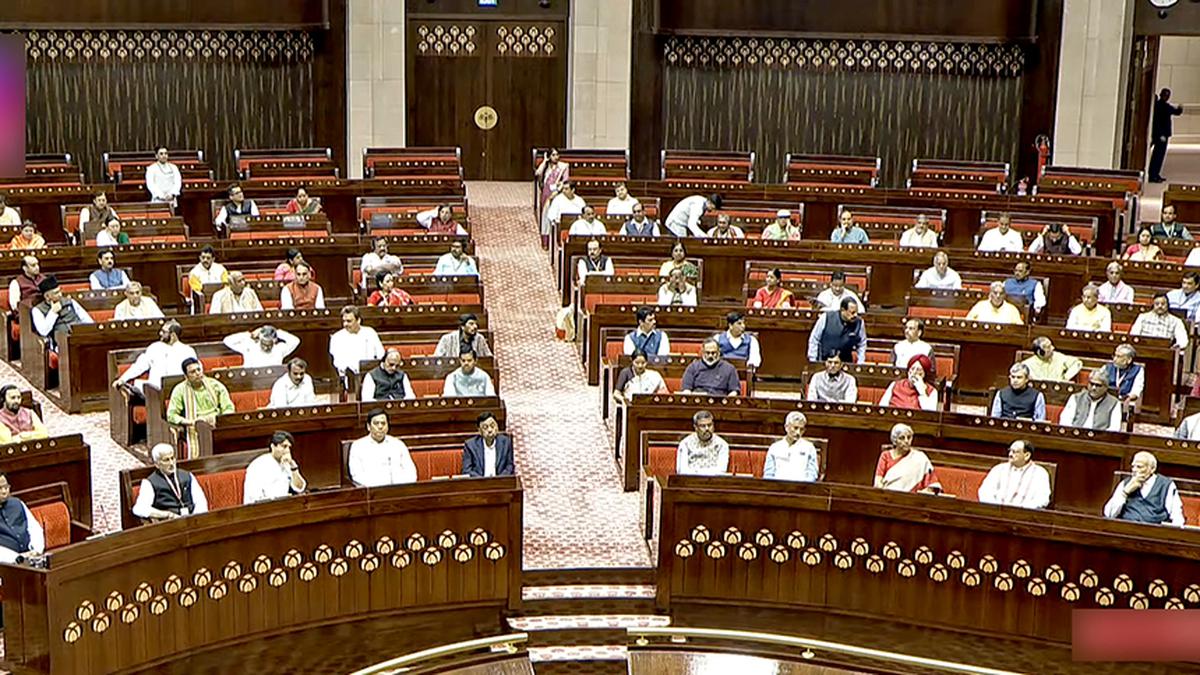
In their new House, MPs explore changes, maintain combative spirit
The Hindu
At the historic first session of the new Parliament building, MPs explored the jazzy new computers, clicked selfies and some demanded tour of the new building. The Women's Reservation Bill was circulated online
If Monday (September 18), the last working day of the old Parliament building — now rechristened “Samvidhan Sadan” — was about nostalgia and memories, Tuesday (September 19) brought with it all the excitement of a new school term in the new Parliament building.
Members of Parliament took time to look around as they entered the building and their respective Houses, clicking selfies and exploring the jazzy new computers at each desk.
In fact, the Nari Shakti Vandan Adhineeyum or the Women’s Reservation Bill was circulated online before its introduction, when the Opposition raised the point that they had not received a copy of the Bill. BJP MP Nishikant Dubey hurried over to the Opposition benches to help them access the online copy, after which their objection was to the specific features of the Bill, and the fact that a decadal census and the delimitation of new seats will have to take place before the reservations can become operational.
As the session in the Lok Sabha was to formally begin at 1:15 p.m. — bang in the middle of lunch and immediately after the ceremonial exit from the Central Hall of Parliament — a couple of MPs driven by hunger pangs went in search of canteen facilities, and had to run around a bit before they located it. “The first thing that needs to be done is for MPs to be given a tour of the place, so that we know where everything is,” said one Opposition MP.
Another MP was seen opening a paper layout of the Lok Sabha to better identify the seat allocations of various parties.
At this historic first session of the Lok Sabha in the new building, the visitors gallery was almost full of women gathered to witness the tabling of the Nari Shakti Vandan Adhineeyum, including actresses Kangana Ranaut and Esha Gupta. A group of women visitors in the galleries raised slogans in praise of Prime Minister Narendra Modi but, in keeping with the rules of decorum while in the Houses of Parliament, Union Ministers Gajendra Shekhawat and Anurag Thakur were sent to ensure that this did not happen again, even as the Opposition benches pointed out that the sloganeering was unseemly.
There were protests from Opposition benches as the Nari Shakti Vandan Adhineeyum was being introduced. The Rajya Sabha too saw a sharp exchange between Leader of the Opposition Mallikarjun Kharge and Finance Minister Nirmala Sitharaman. Clearly, the proceedings may have been in a new House, but the spirit of combat was carried over from the old one.

“Writing, in general, is a very solitary process,” says Yauvanika Chopra, Associate Director at The New India Foundation (NIF), which, earlier this year, announced the 12th edition of its NIF Book Fellowships for research and scholarship about Indian history after Independence. While authors, in general, are built for it, it can still get very lonely, says Chopra, pointing out that the fellowship’s community support is as valuable as the monetary benefits it offers. “There is a solid community of NIF fellows, trustees, language experts, jury members, all of whom are incredibly competent,” she says. “They really help make authors feel supported from manuscript to publication, so you never feel like you’re struggling through isolation.”

Several principals of government and private schools in Delhi on Tuesday said the Directorate of Education (DoE) circular from a day earlier, directing schools to conduct classes in ‘hybrid’ mode, had caused confusion regarding day-to-day operations as they did not know how many students would return to school from Wednesday and how would teachers instruct in two modes — online and in person — at once. The DoE circular on Monday had also stated that the option to “exercise online mode of education, wherever available, shall vest with the students and their guardians”. Several schoolteachers also expressed confusion regarding the DoE order. A government schoolteacher said he was unsure of how to cope with the resumption of physical classes, given that the order directing government offices to ensure that 50% of the employees work from home is still in place. On Monday, the Commission for Air Quality Management in the National Capital Region and Adjoining Areas (CAQM) had, on the orders of the Supreme Court, directed schools in Delhi-NCR to shift classes to the hybrid mode, following which the DoE had issued the circular. The court had urged the Centre’s pollution watchdog to consider restarting physical classes due to many students missing out on the mid-day meals and lacking the necessary means to attend classes online. The CAQM had, on November 20, asked schools in Delhi-NCR to shift to the online mode of teaching.









